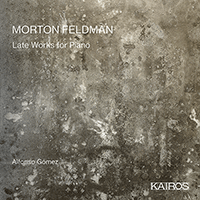Feldman Late Piano Pieces (CD Review)
Morton Feldman
Late Works for Piano
For Bunita Marcus, Palais de Mari, Triadic Memories
Alfonso Gómez
Kairos 3xCD
Morton Feldman’s late piano works are totemic structures, influential on a generation of composers from the Wandelweiser collective to American experimentalists. Slow-moving, prevailingly soft, and quite long, apart from the Palais de Mari, which still clocks in at nearly a half hour in duration. This Kairos recording presents compelling renditions of Feldman in clear, focused sound that captures the pedaling and decay of notes with admirable detail. Alfonso Gómez’s recent recording of Messiaen’s Vingt Regards, also on Kairos, was an impressive outing and he is more than equal to the challenges and subtleties of Feldman’s music.
Feldman often mentioned that the usual late twentieth century pieces, which often were bounded by a somewhat arbitrary 20-minute time frame, were easier for programming. Feldman preferred to think of his predilection for longer pieces as exploring “scale” rather than “form.” Thus the somewhat diffuse direction found in For Bunita Marcus. Written for a composer whom Feldman mentored, it distinctively uses short, thread-like gestures in the middle register in distinctive fashion. These melodic cells are then expanded into dissonant arpeggiations. As is so often the case, the introduction of a new pitch seems like an important event. The pauses and, for lack of a more accurate term, cadential points, are even more so, and beguilingly asymmetrical.
Palai de Mari plays with a widely spaced chordal domain, with two to four sonorities frequently connected in post-tonal voice-leading. A number of the verticals sound like the added note triads found in Poulenc or Milhaud, but they are of course deployed without the sense of harmonic rhythm that propels music by Les Six. These are interspersed with melodic fragments that emphasize the usual seventh and, less usual, fifth. All told, the effect of the piece is that of Feldman exploring different sonorities within his preferred framework of “scale” rather than “form.”
Triadic Memories, clocking in here at nearly an hour and a half, is a journey of thirds set against Feldman’s characteristic use of dissonances. Shifts of pacing are pointed up by Gómez’s rendition, where the tempo ranges from very slow to andante. In general, changes in texture, tempo, and pitch selection are faster than the previous two pieces, yet in the uncoordinated and unexpected nature of these shifts Feldman manages to create music that floats rather than inexorably moving towards a goal. His late fascination with Asian rugs, with their uneven threading, is a worthy analogue to this piece in particular.
Gómez thrives in the epic environments of Messiaen and Feldman. His focus and sense of large-scale pacing are without peer. Recommended.
